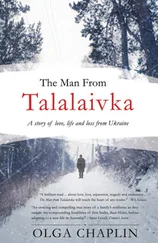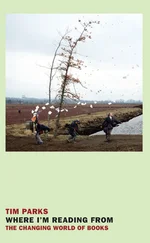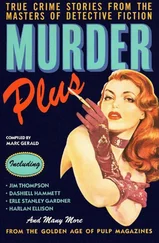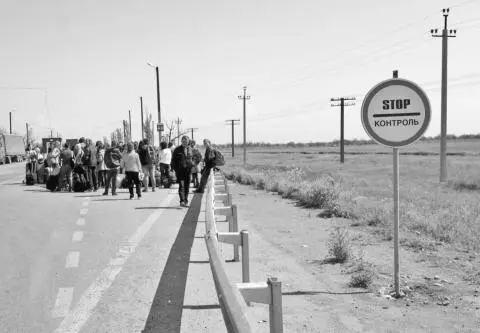
Pedestrians waiting at the Kalanchak checkpoint to cross into Russian-annexed Crimea. May 2015.
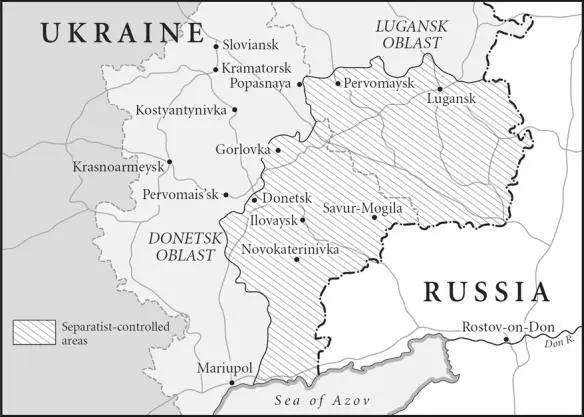
Thinking back on it, it could have been a lyrical scene from an old art house movie. The soft breeze had scattered cherry blossom on the pile of earth that had been dug for the grave of the boy who was about to be buried. From the cemetery we could see for kilometers across the valley and the rolling green hills. Men from the village militia pointed to the horizon and said that their enemies were “over there” somewhere. And then the funeral party came walking up the path from the village.
At their head was a man carrying a cross. Behind him, mixed in with family and friends in the procession, some men carried the lid of the coffin. Then came the pallbearers. For the last time, the spring sun warmed the face of Aleksandr Lubenets, who looked as though he was asleep. He was twenty-one and in a few weeks, his father Vladimir told me, it would have been his birthday. “He was very cheerful. He loved life. And then some bastard decided to end it. They shot him in the back.”
Aleksandr, and two of his mates from the village of Khrestysche, on the outskirts of Sloviansk, decided to investigate something. They were part of the local rebel militia, which had been manning the barricades there for the past few weeks. What exactly happened is unclear. Yevgeniy, the commander of Aleksandr’s group, said “he wanted to be hero.” They ran into Ukrainian soldiers or police and that was the end of it. As Aleksandr was buried, five uniformed men fired their Kalashnikovs into the air over the grave in salute.
Aleksandr died on April 24, 2014. On the same day Volodymyr Rybak, who was forty-two, was buried. A policeman turned local councillor, he remonstrated with rebels when they put up the rebel flag in his hometown of Gorlovka. A few days later he and a man later identified as a student from Kiev were found in a river near Sloviansk. Rybak’s corpse showed signs of torture. When his body had been tossed into the river it had been weighted down with a bag of sand. As mourners came to pay their respects, Elena, his widow, sat by his open coffin stroking his face. Makeup had been applied to the wounds on his head.

Elena Rybak, widow of murdered politician Volodymyr Rybak, strokes his face before he is buried. Gorlovka, April 2014.
The war had started and Aleksandr and Volodymyr were among the first to die. That is why their names are remembered, why journalists wrote about them and why they are recorded here. After that, those who died became a statistic to everyone but their families and friends. Individual names and faces gave way to the torrent of numbers.
Since the seizure of Crimea the conflict has proceeded in fits and starts. The war in the east began on the pro-Russian side in a mood of euphoria. The oblasts of Donetsk and Lugansk would be snapped off, followed by Kharkiv and then all the other regions, including Odessa, up to the Romanian border in Bessarabia. No secret was made by the separatist side that this was their intention. The flag of Novorossiya would fly all the way from Lugansk to Izmail on the Danube, before being replaced with that of Russia. Just before the May 11, 2014, separatist referendum in Sloviansk, an A4 sheet setting out what it was all about was pasted to the walls. It explained that the Donetsk People’s Republic had to become independent before it joined Russia, because the region could not be incorporated into Russia as long as it was “still part of the territory of another country.”
As soon as Crimea was taken the campaign began in the east. Key buildings were seized, one by one, by armed men. Exactly how this operation was coordinated will be for historians to lay bare, but it was clear to almost everyone that this was not something that could be done without the involvement of the Russian security services. Putin denied this was the case, but he had denied that Russian troops were involved in the takeover of Crimea and later had admitted it, and they were decorated with a specially struck medal.
At first Ukrainian authority seemed to evaporate and the Ukrainian military appeared uncertain what to do and how to react. There were good reasons for this. Since independence in 1991, the armed forces had been starved of funds. Almost the entire defense budget had gone on paying (poor) salaries and there was little left over for modern weapons and training. It was not as though Ukraine did not make arms either. In the period 2009–13 it was the eighth-largest arms exporter in the world, responsible for 3 percent of global sales, though a good proportion of this went to Russia. It was simply that with money being stolen and siphoned off, the military could not afford the modern stuff, which the country’s arms manufacturers exported. Some of the top ranks of the military also had an extremely close relationship with their Russian counterparts. One of the consequences of the breakup of the Soviet Union was that brothers and friends now found themselves as senior officers in armies which, all of a sudden, had become enemies. The result of all this was an army with only a few thousand combat-ready troops with very low morale. I discussed this with a senior intelligence official, who began by talking about the police, claiming they had been turned into a “racketeering organization” for their bosses in the regions and in Kiev. Since independence, he said, Ukraine had claimed to have “an intelligence service, counterintelligence and an army, but it was all just a façade.” In an apposite phrase, Tetiana Sylina, a well-known Kiev journalist, summed up the reason for this: Ukrainian politicians had a “bulimic” appetite for corruption. The security source drew parallels with African countries.
In the wake of the Maidan revolution several things happened on the Ukrainian side. In the first weeks after the flight of President Yanukovych, there was such chaos that few were really in proper control. This was why it was possible for Crimea to be taken so easily and why it was then wrongly assumed in Moscow that the east and the south would fall just as easily into their lap. But now, dozens of militias began to spring up on the Ukrainian side, the kernel being men who had fought on the Maidan. At the same time a plan to set up a National Guard was put into place. Igor Kolomoisky, one of Ukraine’s richest and most powerful oligarchs, who was appointed governor of Dnipropetrovsk after the revolution, put up money to pay for some of them. The problem was that at the beginning this led to anarchy on the battlefield, which provided a window of opportunity for the anti-Maidan, pro-Russian rebels. With at least some Russian direction and help, including from leaders like Igor Strelkov in Sloviansk and some of the first DNR commanders who were from Russia, not locals, the rebels were able to take territory quickly, given that there was initially no real resistance. When I asked the security service source who was in charge of the volunteers on the Ukrainian side, he said bluntly, “Nobody.”
Quite apart from there being no credible force to oppose the rebels and Russia, no one had any real idea what to do. The reason for this was simple, said the intelligence source. A few years back he and his colleagues had written a paper on a possible Russian threat, which they argued could happen after the Sochi Olympics of 2014. Extraordinarily these ended on February 23, a few hours after the flight of Yanukovych from Kiev. However, when they wrote the report it had all seemed like a far-fetched “intellectual game.” He said, “In my soul, I did not believe we would fight with Russia.” So, no one ever made any preparations for any such conflict in any possible variation of it. For this reason much of Ukraine’s threadbare army was positioned in ways which reflected its old Cold War Soviet background, i.e., prepared, albeit barely, to fight a war on its western flanks—not its eastern ones.
Читать дальше




